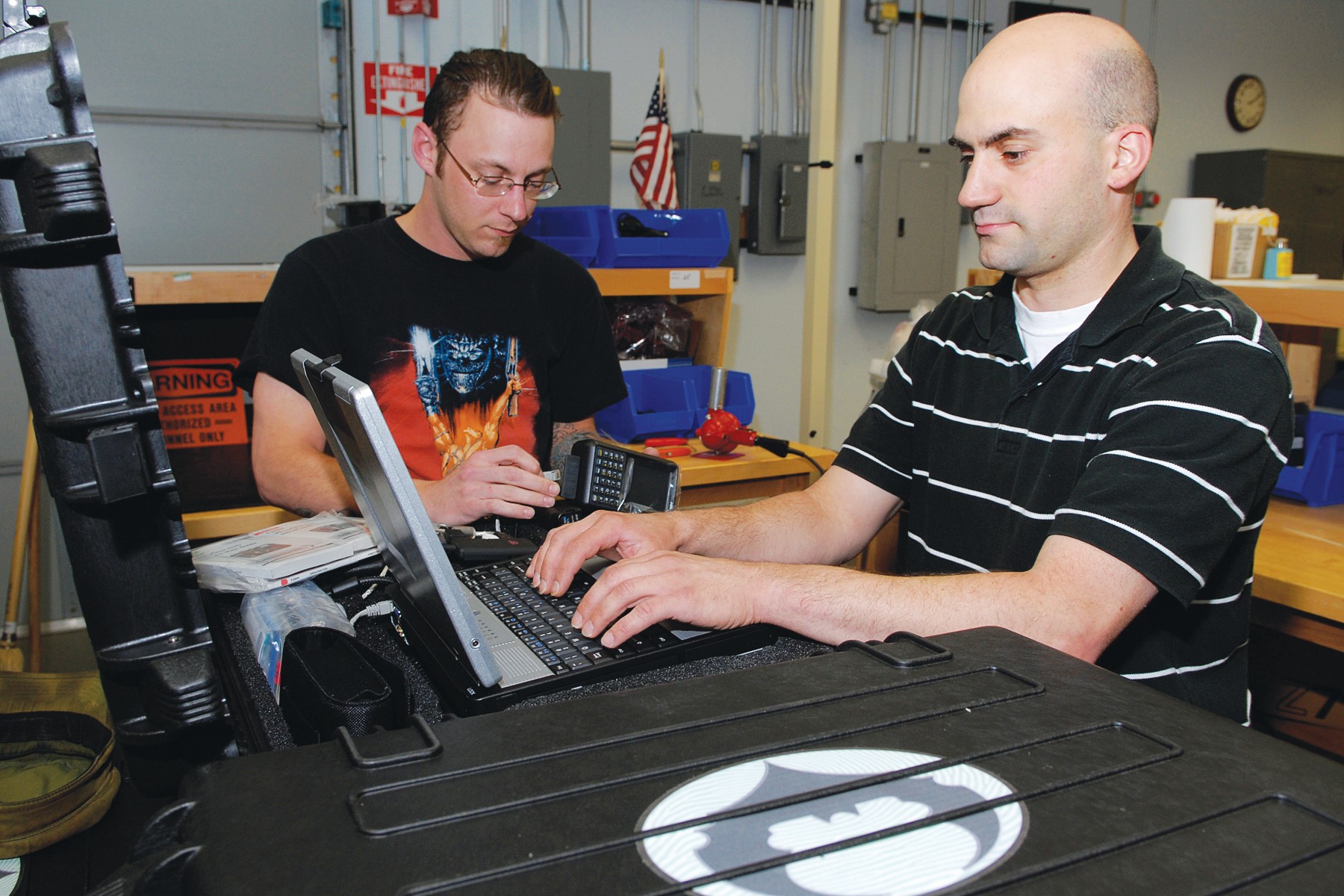TOBYHANNA ARMY DEPOT, PA. (Aug. 6, 2010) -- Tobyhanna provides service and support for a Defense Department program that develops and deploys tools to verify the identity of people entering and exiting U.S. controlled military installations and during military operations worldwide.
Computer Service and Repair Branch employees assembled more than 100 new mobile Biometrics Automated Toolset kits for shipment to Southwest Asia. The BAT is one of several biometric systems in use by DoD that uses unique physical factors such as fingerprints, iris or facial images to confirm identity.
The BAT consists of a laptop computer with identification processing software and peripheral devices, including a hand-held iris scanner, digital camera and fingerprint reader.
Last year, warfighters asked DoD Biometrics to simplify the BAT kit's design, provide easier access to the components, cut down on the number of parts to assemble and find a way to keep the system operational in extreme temperatures.
DoD Biometrics is part of the Army Program Executive Office, Enterprise Information Systems.
"In an effort to streamline a systems' operational state, we improve effectiveness and efficiency of the warfighter thus we are able to devise a better way to do business," said Curtis Matchett, contract support logistics specialist, PM DoD Biometrics. "Now all the BAT components are configured and connected in a hardened case at the depot. Users simply open the new case, plug the system into a power source and go to work."
"By reorganizing the items and storing them in a hardened case, we were able to cut the assemble/disassemble time significantly, increasing operational readiness for the system user," he added.
The idea for the kit's redesign came from a prototype built by a Soldier stationed in Afghanistan, according to Joe DeLong, equipment specialist in the Production Engineering Directorate's Cost Development and Analysis Branch.
"The depot joined forces with PM DoD Biometrics and a commercial foam company to engineer a kit that meets the customer's needs," he said, adding that the kit boasts a carrying case with a lifetime warranty and pre-cut foam that boosts air flow. "It's satisfying to see everything come together to benefit the warfighter."
The new design consists of a hardened case, two layers of foam separating and protecting the power cables and cords, on the bottom, from the computer and peripheral equipment on the top. A laptop cooler is placed (upside down) under the laptop to force air down into the power supply bay and dissipate the heat buildup.
Soldiers in the field gave high marks to the new mobile BAT design.
"Great job Tobyhanna," wrote one user, pointing out that the kit can now be placed on the hood of a Humvee, plugged into a power port and powered up. Plus, the peripherals are already plugged in and ready for immediate use, the Soldier added.
"The whole point of the kit is to make everything readily accessible to the warfighter," said Martin Tucky, an electronics mechanic. "All the power cords and cables are attached to a power strip and the individual components. Users no longer have to spend time in the field assembling or disassembling the system."
Originally, BAT components and hardware were carried in a soft-sided carrying case. Backpacks were introduced years later.
Joe Costanzo remembers carrying the backpack version of the BAT while deployed to the desert. He remarked that the difference between the old and new kits is like night and day.
"The new way is definitely a time saver," the logistics management specialist said. "Engineering was able to devise a way to lay everything out neatly and ventilate the components so they stay operational in the extreme temperatures."
One warfighter said the vent areas engineered into the edges [of the foam] to match the laptop cooler were "ingenious." The system was tested in 120-degree weather and users realized that flipping a laptop cooler upside down did a better job of cooling all the components, preventing equipment failure.
Employees are able to assemble the BAT kits within a matter of hours by applying several techniques to the kitting processes.
"Command, Control and Computers /Avionics Directorate process improvement specialists worked with the shop to streamline our process to make it more efficient," said Dennis Redding, branch chief. "Their efforts have contributed to the success of this mission."
To create an efficient workspace, branch officials turned to Matt Kalinowski, who helped tape off the space and provide storage devices to keep components handy.
"I'm really pleased with the outcome so far," Kalinowski said. "But, I'm more excited with future possibilities as we learn more about the process and workload."
Electronics worker Anthony Volper likes the way the work cell is set up.
"Having everything organized makes the work go faster," Volper said, adding that the job is very satisfying. "It's nice to know the work we're doing helps the troops in the field."
The BAT was developed in 2001 and first deployed in Kosovo. Following the terrorist attacks of Sept. 11, 2001, DoD recognized the value of biometric technology to provide automated methods capable of rapidly determining an individual's true identity, previously used identities and past activities. Today, thousands of BAT systems are deployed worldwide.
"This biometrics initiative coupled with Tobyhanna Army Depot efforts has provided an improved BAT system in the field that has increased operational readiness, capability, efficiency and effectiveness of the warfighter," said Matchett.
Tobyhanna Army Depot is the Defense Department's largest center for the repair, overhaul and fabrication of a wide variety of electronics systems and components, from tactical field radios to the ground terminals for the defense satellite communications network. Tobyhanna's missions support all branches of the Armed Forces.
About 5,600 personnel are employed at Tobyhanna, which is located in the Pocono Mountains of northeastern Pennsylvania.
Tobyhanna Army Depot is part of the U.S. Army CECOM Life Cycle Management Command. Headquartered at Fort Monmouth, N.J., the command's mission is to research, develop, acquire, field and sustain communications, command, control computer, intelligence, electronic warfare and sensors capabilities for the Armed Forces.


Social Sharing